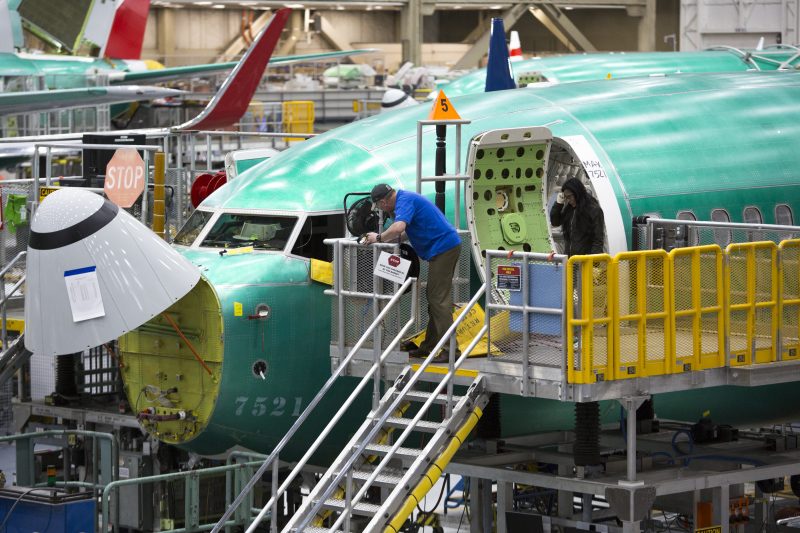Boeing unveils fix to flight system after deadly crashes
Boeing employees work on a 737 MAX jet at the company’s factory in Renton, Washington — the aviation giant has unveiled a fix to the software system of the jet, which has suffered two deadly crashes in recent months (Jason Redmond)
Renton (United States) (AFP) – Embattled aviation giant Boeing pledged Wednesday to do all it can to prevent crashes like the two that killed nearly 350 people in recent months, as it unveiled a fix to the flight software of its grounded 737 MAX aircraft.
Boeing gathered hundreds of pilots and reporters to unveil the changes to the MCAS stall prevention system, which has been implicated in the tragedies in Ethiopia and Indonesia, as part of a charm offensive to restore the company’s reputation.
“We are going to do everything to make sure that accidents like this don’t happen again,” Mike Sinnett, Boeing’s vice president of product strategy, told reporters.
Meanwhile, across the country in the nation’s capital, the head of the US air safety agency will face harsh questions from senators over its relationship with and oversight of Boeing.
Transportation Secretary Elaine Chao and other top officials were also on the hot seat on Capitol Hill Wednesday.
Boeing chief Dennis Muilenburg will be absent from the Senate hearing, which was to begin at 1900 GMT, but is expected to testify at a later date.
Ahead of the major day of reckoning, the company launched a campaign to convince the flying public that it is addressing the issues with the 737 MAX, including a fix to the Maneuvering Characteristics Augmentation System (MCAS) implicated in the deadly crashes.
At the company’s massive factory in Renton, Washington, Boeing unveiled the software changes and offered reassurances.
Sinnett said it will take only about an hour to install the updates and they can begin as soon as regulators authorize the changes, which were developed “after months of testing and hundreds of hours.”
– Authorization pending –
The MCAS, which makes the aircraft dive in order to regain speed if it detects a stall or loss of airspeed, was developed specifically for the 737 MAX, which has a heavier engine than its predecessor, the 737 NG.
Among the changes, the MCAS will no longer repeatedly make corrections when the pilot tries to regain control, and will be automatically disconnected in the event of disagreements between the two “angle of attack” (AOA) sensors, the company said.
This is a major change because until the Ethiopian Airlines tragedy earlier this month, the MCAS was set to react to information from a single sensor and would repeatedly override pilot corrections.
The initial investigation into the Lion Air crash in Indonesia in October found that one of the AOA sensors failed but continued to transmit erroneous information to the MCAS.
Boeing also will install a warning feature — at no cost — called a “disagree light” to indicate to the pilot when the left and right AOA sensors are out of sync.
The company also is revising pilot training, including for those already certified on the 737, to provide “enhanced understanding of the 737 MAX” flight system and crew procedures.
– ‘Directly involved’ –
In Washington, US aviation regulators were to face the music amid questions about how certification for the MAX was handled.
Lawmakers also want to know why officials delayed the decision to ground the aircraft following the Ethiopian Airlines tragedy, in which a MAX 8 crashed shortly after takeoff near Addis Ababa, killing all 157 people onboard.
The delay has given rise to suspicions of a too-cozy relationship between regulators and the American aircraft manufacturer, especially since Chinese and European authorities moved quickly to ban the planes due to the similarities with the Lion Air crash.
Dan Elwell, the acting head of the Federal Aviation Administration, which sets standards for air safety around the world, has defended his agency.
The FAA — which delegates some certification procedures to Boeing, including parts of the MAX — was “directly involved” in the safety review of the MCAS, Elwell said in his prepared testimony, obtained by AFP.
“The certification process was detailed and thorough,” but “time yields more data,” Elwell was to tell senators.
He acknowledged that as systems become more complex, the FAA’s “oversight approach needs to evolve.”
At a separate hearing, Chao said she was “concerned about any allegations of coziness with any company,” but noted that allowing Boeing to handle some of its own safety certifications was necessary because the FAA “can’t do it on their own.”
The FAA chief also was to reassure senators that regulators will not rush the MAX back into the skies.
“The 737 MAX will return to service for US carriers and in US airspace only when the FAA’s analysis of the facts and technical data indicate that it is appropriate,” Elwell was to say.
Disclaimer: This story is published from a syndicated feed. Siliconeer does not assume any liability for the above story. Validity of the above story is for 7 Days from original date of publishing. Content copyright AFP.


